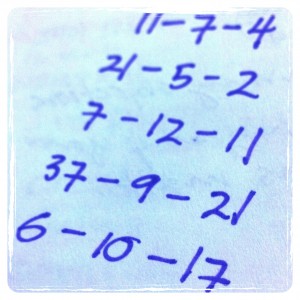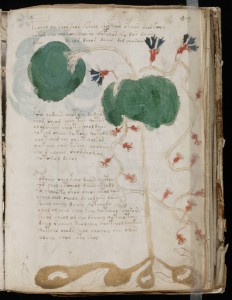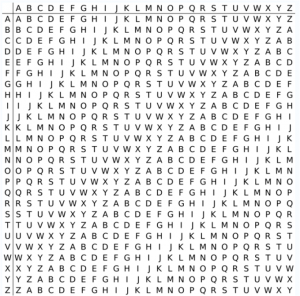 by Malak Elmousallamy (Vanderbilt University)
by Malak Elmousallamy (Vanderbilt University)
“You can do a lot with a book, besides read it!”- Albert C. Leighton and Stephen M. Matyas
Ever wondered what those numbers in the letter Sherlock Holmes received in The Valley of Fear had to do with the murder of John Douglas? Or how a Bible Michael stole in season two of Burn Notice dominated the entire season’s plot? Or why the coordinates on the back of the Declaration of Independence in the movie National Treasure led to the discovery of the most elusive treasure in history?
The answer is that they were all clues to revealing the content of hidden messages that employed the technique known as book ciphers. Book ciphers are a means of enciphering written communication using a piece of text from a book as the key. As it turns out, this method of concealing information holds true beyond the entertaining world of fiction and has been a recurring phenomenon throughout history. (Leighton and Matyas, 1985)
Throughout the history of cryptography, there has been an unrelenting battle between code makers and code breakers- each desperate to gain the upper hand. Cryptographers worked continuously to create new ways of enciphering messages, and cryptanalysts were equally persistent to reveal their content. It comes as no surprise then, that in 1526, almost seventy years after the first efficient method of commercial printing was discovered, (British Library, n.d.) cryptographers were already thinking about how to use a book in order to obscure a message. Jacobus Silvestri, one of the ancestors of cryptography, was the first to describe a true book cipher. He recommended the use of a codebook as a means of concealing information and devised a sort of dictionary with root words placed in multiple columns. Every row and column is assigned a unique symbol and additional symbols were allocated to commas, question marks and other grammatical inflections. The Voynich manuscript, whose origin and content remain a mystery, is believed by some to have been enciphered using this technique. (Leighton and Matyas, 1985)
By 1586, Blaise de Vigenere had already thought of several ways to use a book for cryptographic purposes. His first suggestion was to place a transparent sheet over the pages of a book and underline the words one wished to include in the message. The recipient of the message, or in this case the transparent sheet, would then place the sheet onto their own copy of the book and match the lines to the words on the page in order to reproduce the message. This was a rather primitive and impractical method of concealing messages since finding the desired words in the order they are found in the message, on a page or so of text is unlikely. His next suggestion, and what is arguably the most widespread version of a book cipher, is to match letters in a text using a triple coordinate system. This basically means that the first number of the coordinate referred to a page number in the book. The second number referred to a line, and the third number referred to the location of the letter in that line. For example, if you were trying to encipher the letter ‘C’ using Singh’s The Code Book, then you would go to the first page, second line and fourth letter of that line, encrypted as (1,2,4). That way, any combination of letters or words could be manufactured using a relatively small text. The advantage of this method is that one needs only to memorize a short piece of text, perhaps a popular poem, without running the risk of having to carry a codebook around and risking it falling into the wrong hands. However, this process of encoding individual letters can be tedious and time-consuming, and there is much room for error. It is also not unbreakable because the text used as the key can potentially be located, and the process of encryption can simply be reversed. (Leighton and Matyas, 1985)
In the eighteenth century, Christian Breithaupt modified this method of enciphering messages by suggesting the use of the numbers for the page and line in which the desired letter occurs first. This means that the key is restricted to the first few pages of a book as opposed to the book as a whole. He also echoed the sentiment that this method does not provide as much security as cryptographers would like since a clever investigator might find out what key book was used. Later in the century, Philip Thicknesse writes of a similar method in which a numeric code is used to refer to words in a book by page, line and word number. (Leighton and Matyas, 1985)
With the urgency presented by the American Revolution looming in the air, several adjusted and improved versions of book ciphers were produced. Numbering schemes were adopted which allowed for the enciphering of individual letters. This made the process somewhat more practical and precise. An example of which is in the letters that Benjamin Franklin received from his translator, Barbeu-Dubourg, in Paris on June 10,1776. Barbeu-Dubourg explains that security can be achieved by numbering each letter in the key text, as opposed to numbering the entire word or just the letters in a single word. For example, if a line began with “Mary Queen of Scots,” then the letter M would be numbered 1. The letter A would be numbered 2, and the letter Q would be numbered 5, as opposed to going back to 1 again. Implementing this numbering technique avoids the confusion as to which word is being used as the key. (Leighton and Matyas, 1985)
Finally, in modern-day history, we encounter book ciphers in the form of the elusive Beale Ciphers. These ciphers are thought to have been left by a man named Thomas Jefferson Beale in which he detailed the exact location, content and owners of a substantial treasure. The second of these ciphers was successfully decrypted some years later and included a description of the treasure. This cipher was constructed using a version of the Declaration of Independence as the key, where every word was numbered in order. To decrypt the text, the numbers in the cipher text were matched to the numbered words in the Declaration of Independence. By taking the first letter of the selected words, the hidden message could be reconstructed. The other two ciphers, which are thought to detail the location and owners of the treasure, have yet to be cracked. (Singh, 2000)
Book ciphers continued to develop over time and eventually led to the creation of what is considered the only unbreakable cipher. The running key cipher, which is the only method of concealment that has withstood cryptanalysts’ efforts, is constructed by using the book as the key text. In this case, the individual letters in the text are used as the key and avoid repetition. For example, if you were to use Singh’s The Code Book as your key, then you would begin to encrypt the plain text “meet at dawn” using the first line, “On the morning of…”. The first letter of the key is ‘O’ and so we would go to the row that starts with ‘O’ in the square drawn below and encrypt ‘M’ as ‘A’, and so on. The security of the running key cipher lies in its continuity- that is that the key does not repeat itself. The key is simply comprised of the words of the novel, which do not have a recurring patter. In this way, the running key cipher can withstand all the conventional methods of cryptanalysis.
So, the next time you are about to dismiss some seemingly unrealistic code or cipher you see in a movie or read in a book, think about how it might actually be based on reality, and how the real world is really much cooler than we think it is.
This post is part of a series of essays on the history of cryptography produced by students at Vanderbilt University. The students wrote these essays for an assignment in a first-year writing seminar taught by mathematics instructor Derek Bruff. The essays are shared here, in part, to give the students an authentic and specific audience for their writing. For more information on this cryptography seminar, see the course blog.
References
- Leighton and Matyas, A.C.L. and S.M.M. (1985). The history of book ciphers. Proceedings of CRYPTO 84 on Advances in Cryptology.
- British Library. (n.d.). Gutenberg Bible: The Basics. Retrieved from http://www.bl.uk/treasures/gutenberg/basics.html
- Singh, S.S. (2000). The Code Book: The science of secrecy from ancient Egypt to quantum cryptography. New York, NY: Anchor Books.


